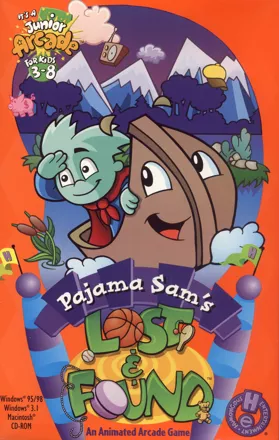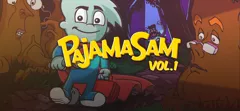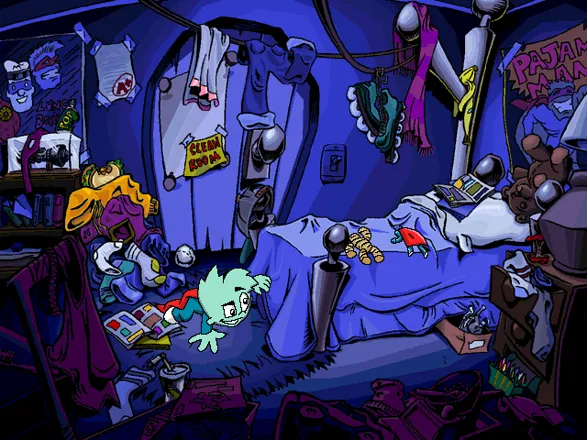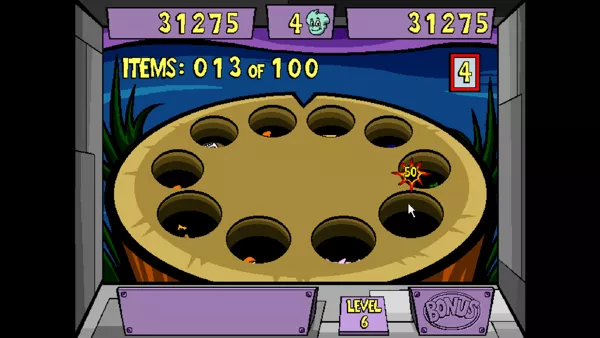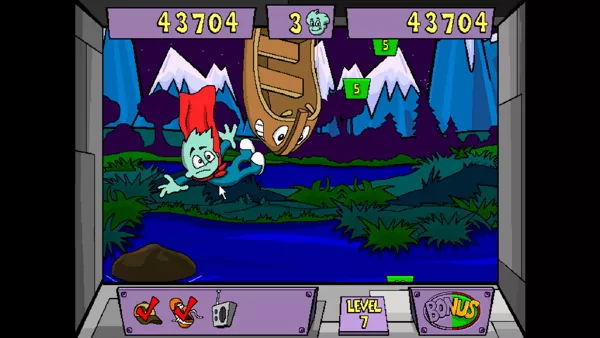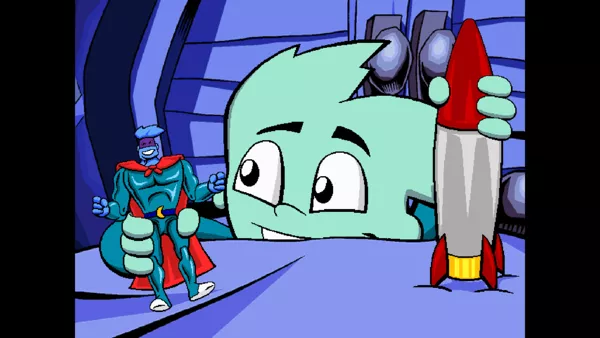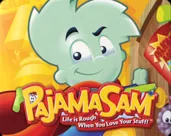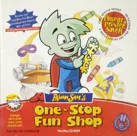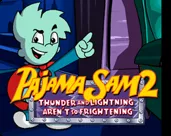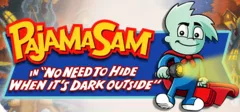Pajama Sam's Lost & Found
Description
Sam's room is a total mess and has lost some of his things throughout the lands he has visited in the past and in new areas. Now as Pajama Sam it is up to you, Sam and some old friends to travel around paths collecting puzzle pieces and Sam's toys and avoiding strange obstacles.
Also play bonus games to earn extra points and be the Toy Rescue champ, in this children's arcade game.
Groups +
Screenshots
Promos
Videos
Add Trailer or Gameplay Video +1 point
See any errors or missing info for this game?
You can submit a correction, contribute trivia, add to a game group, add a related site or alternate title.
Credits (Windows version)
39 People · View all
| Interactive Design | |
| Programming Lead | |
| Art Lead | |
| Programming | |
| Lead System Programmer | |
| System Programmers | |
| Macintosh Game System | |
| Pajama Sam Animation | |
| Digital Ink and Paint | |
| Background Art and Animation | |
| [ full credits ] | |
Reviews
Critics
Average score: 60% (based on 3 ratings)
Players
Average score: 3.3 out of 5 (based on 3 ratings with 1 reviews)
Another unremarkable Junior Arcade, but with bonus puzzle pieces
The Good
This marks Pajama Sam's second and last Junior Arcade. His first one, although a pretty shameless rehash, was at least a rehash of something rather decent and ended up being one of the better games in the series as a result. Sadly, I can't say the same for this one.
Credit where credit is due however. Compared to Pajama Sam's Sock Works, the graphics here do a far better job at capturing the essence of Pajama Sam's Junior Adventures. The background elements feature the same kind of wild and outlandish artwork you can find there, and their extensive use of parallax scrolling really helps bring them to life. There is a reasonable amount of variety to the locations as well, with the game being split into five different ones, among them two from Pajama Sam's first Junior Adventure, one from his second and two original ones.
The Bad
The gameplay on the other hand is nothing to write home about. Just like Spy Fox in Cheese Chase, it's an endless runner that's all about grabbing items and dodging obstacles. The key difference is the perspective. Rather than a top-down view, you see Sam and his vehicular companions from their side. And instead of shooting, you can jump on your own now, so this game can also be considered a platformer.
It is however one of the most repetitive platformers I've ever seen. The main objective is to collect as many items as possible. They tend to float through the air at greatly different heights. The camera doesn't cover the full height of the level, so you need to endlessly jump all the time, just to make sure you don't miss any.
Along the way, various obstacles show up. There are minor obstacles that just spin you upon contact and usually aren't a big deal, but major obstacles will send you back and rob you of a life when touched. The idea is that you're supposed to jump over them most of the time, and this aspect of the game is actually handled surprisingly well. With the jumps reacting to the length of your clicks, and your speed adjusting itself depending on your position on the screen, you have a remarkably high level of control over both the height and duration of each individual jump. It does legitimately feel satisfying to perform a jump that just barely makes it over an obstacle, yet still manages to fly in just the right angle to collect all the items floating above it. The developers actually managed to create some rather solid platforming physics.
It's a shame that said physics aren't put to much good use, with the game being too mechanically simplistic to offer any real variety. The challenges just involve endless jumps over the same obstacles again and again. The addition of timed obstacles does mix things up a bit halfway through, but it's not much. When a level in the game's second location introduced the concept of obstacles in the air, I expected them to throw a wrench in my strategy of endlessly jumping, but they wasted that potential by seemingly never appearing again in later locations. As a result, very few of the levels do anything to stick out from the rest.
There is also another way of dealing with obstacles however. If you click while ducking, you'll spin out of control for a moment and destroy anything you hit. I never would have expected this, considering the game never told me. Plus, obstacle-induced spinning, despite using the same animations, doesn't seem to have this property. What makes things even more confusing is that you need to wait a moment for the spinning's protection to kick in. If you hit an obstacle immediately after starting, you'll still lose a life. As a result, it took me some practice to really get the hang of this mechanic. But once I fully mastered its timing, I managed to pretty much break the game in half with it. With the ability to just destroy them instead of trying to jump over them, most obstacles no longer posed any threat to me. The developers clearly expected players to make at least some use of this mechanic, considering some items are literally impossible to get without it, but I don't think they anticipated the full extent to which it could be exploited. A lot of the time, it's more effective than jumping, but it also takes most of the challenge out of the game, so I unfortunately have to consider it a negative overall, despite the interesting concept of picking between jumping and spinning.
There are also two powerups that show up every now and then. The invincibility stars are just what you'd expect. They allow you to briefly destroy any obstacles you touch, so they're useful, but don't exactly open up much in the way of strategy. The wings on the other hand arguably make the game harder for a short while. Being able to just fly through the air sounds nice, but considering how high you can jump, you don't really need that. And they disable your ability to spin, making you more vulnerable to obstacles. I only recall a single occasion in the game where I found them legitimately useful.
Other items primarily include ones that simply award you some points, but also extra lives, key items and bonus puzzle pieces. Key items are the only ones you actually have to obtain. If you miss any, the level will keep looping over and over until you get the rest.
Bonus puzzle pieces on the other hand let you play one of three minigames of your choice at the end of each level whenever you get them all. I immediately found that my reflexes are good enough to consistently get a perfect score in the Whack-A-Mole game, so in the interest of maxing out my points, I picked it every single time. I initially expected points to be important, since they're your primary source of extra lives. By the time I realized the game was never going to get hard enough for those to actually matter, I'd already made so much progress that I figured I might as well continue for the sake of getting a really good high score. In hindsight, it really wasn't worth it and made for an incredibly boring experience, since I was so good at getting bonus puzzle pieces that I wound up playing this game over 90 times. I later tested out the other two minigames as well, but found that both of them were also repetitive and boring, with one just being a game of Concentration where you can see the cards for a few seconds at the beginning, and the other being a very simple catching game. If you're not as much of an obsessive perfectionist as I am, it would probably be in your own interest to skip the minigames entirely once you've seen them all, as they're just the same experience over and over again.
Sound-wise, the game leaves a lot to be desired. Once again, Humongous Entertainment's budget apparently wasn't sufficient for a new soundtrack, so the game largely just re-uses parts of Jeremy Soule's soundtrack for Pajama Sam's Sock Works and Julian Soule's soundtrack for Pajama Sam 2. They're all decent tracks, but far from the best we've heard in Humongous' games. Only two tracks are new, and they're not really all that remarkable. There aren't a whole lot of tracks overall, with some notable spots in the game, such as two of the minigames and the credits, having none at all.
But that's not even my biggest gripe with the game's sound. That has to do with the game's bonus puzzle pieces. You see, Sam seems to care a lot about those and he expects you to care, too. So on every single occasion where you get one, he'll proclaim "I picked up a bonus puzzle piece." The problem with this is that bonus puzzle pieces are incredibly frequent in the game. Whether you want them or not, you'll pick them up every few seconds, and so Sam's endless proclamations of bonus puzzle pieces will drown out everything else during gameplay. As a result, this game's soundscape is nothing short of maddening. For a while, I considered strewing instances of this line between every single paragraph of this review in order to give a rough demonstration of what this is like, but in the interest of maintaining readability, I decided to refrain. Plus, in order to convey the true Pajama Sam's Lost & Found experience, I'd have to go as far as to put this line between every individual sentence.
What's really strange is that the game has no save feature or level selection screen. Instead, it actually uses a password system, something that Humongous has only employed a single time in the past in the obscure standalone version of Bear Stormin'. I have no idea what they were thinking here. Did they somehow forget they're developing this game for a platform that has the ability to permanently save data? I'm all for retro throwbacks, but not like this.
There's no level editor either. A bit strange, considering I wouldn't expect the game's level structure to be all that complex, but then again, I don't think you could design very interesting levels for it anyway.
At least there are some cheats available that can give you unlimited lives or reduce the threat of obstacles even further by making all of them just spin you. They're not called Junior Helpers this time, but they accomplish the same purpose of making the game more accessible to younger players.
The Bottom Line
1998 was apparently Humongous Entertainment's year of the mindless endless runners, with this game once again being a very simplistic experience. It could have been nice as a minigame in a Junior Adventure, but there's too little substance or elegant design to it for it to be entertaining for more than brief bursts. And while it's nice to look at, it certainly isn't pleasant to listen to. So it's another Junior Arcade that's easy to forget about.
I picked up a bonus puzzle piece.
Windows · by SomeRandomHEFan (164) · 2022
Analytics
Upgrade to MobyPro to view research rankings!
Identifiers +
Contribute
Are you familiar with this game? Help document and preserve this entry in video game history! If your contribution is approved, you will earn points and be credited as a contributor.
Contributors to this Entry
Game added by Andrew Shepard.
Linux, Windows 3.x added by Sciere.
Additional contributors: vedder.
Game added October 3, 2005. Last modified January 21, 2024.
